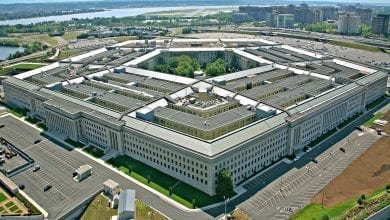Medal of Honor Monday: Army Maj. Gen. Charles Calvin Rogers
From the 1950’s to the 1980’s, a lot changed in America and abroad, and Army Maj. Gen. Charles Calvin Rogers served through all of it. As a Black man, he worked for gender and race equality while in the service. But he’s perhaps most well-known for his leadership during an intense battle in Vietnam, which earned him the Medal of Honor.
Rogers was born on Sept. 6, 1929, and grew up with his brother and three sisters outside of the coal-mining town of Claremont, West Virginia. Rogers’ dad was a coal miner and World War I veteran, which could be what nurtured his desire to serve.
Rogers, who attended the all-Black Dubois High School during the segregation era, excelled as a student. He was consistently on the honor roll, played quarterback for the football team and was elected the student body president. He graduated in 1947 and attended West Virginia State College (now University), where he earned a degree in mathematics. Rogers commissioned into the Army through ROTC after he graduated in June of 1951.
His first few years as a soldier were spent serving in artillery commands while the service was being desegregated. Rogers worked his way up the ranks and was sent to the Army Command and General Staff College when he was a major. After graduating in 1964, he was sent to Germany — his second stint in the country — to train an artillery unit. After that, he earned his first battalion command at Fort Lewis in Washington.
Rogers was put in command of the 1st Battalion, 5th Artillery, 1st Infantry Division, and sent to Vietnam in July 1967. He spent the next two years on the battlefront.
Battle at the Border
On Oct. 31, 1968, then-Lt. Col. Rogers’ artillery unit was positioned at Fire Support Base Rita in southern Vietnam. It was close to the Cambodian border and the Ho Chi Minh Trail, a supply route that the North Vietnamese Army used to shuttle supplies and troops into South Vietnam.
That evening, Rogers noticed a lot of activity across the border, but the rules of engagement said he couldn’t fire into Cambodia, so he waited. The NVA didn’t follow such rules, though. Around 3:30 a.m. on Nov. 1, they bombarded FSB Rita with heavy mortars, rockets and rocket-propelled grenade fire. Soon enough, their soldiers breached the defensive perimeter of the base. Finally, Rogers’ battalion could attack, and he made sure he was right at the forefront of the action.
Holding the Line
Rogers ran through a hail of exploding shells to rally his dazed crewmen into firing their howitzers back at the much larger enemy. Despite being hit by an exploding round, he led some of those men in a ground battle against enemy soldiers who’d breached the howitzer’s position. Rogers was again wounded during that foray, but he continued fighting, killing several enemy soldiers and driving the rest back.
Rogers refused medical attention and instead worked to get the defensive perimeter set back up.
When more enemy troops poured through a different section of the defensive line, Rogers directed that artillery fire, too, and led another successful counterattack on the charging forces, encouraging his men throughout the difficult endeavor.
At dawn, the enemy tried to overrun the base a third time, so Rogers continued directing his unit’s fire. He even joined a struggling howitzer crew after several men were hit by enemy fire and the gun had been rendered inoperable. Rogers helped the crew get the massive gun operating again, but in doing so, he was hit a third time. He could no longer physically help his men, but he continued to direct and encourage them.
Rogers’ valor helped push back the enemy that day, which finally retreated for good. Twelve U.S. soldiers died and dozens more were wounded; however, Army records show that the casualties on the enemy’s side were much higher.
The Highest Honor
Rogers’ wounds were eventually treated, and he returned to the U.S in August 1969. On May 14, 1970, he received the Medal of Honor from President Richard M. Nixon during a White House ceremony.
Rogers continued his career in the Army. He attended the Army War College in Carlisle, Pennsylvania, and graduated in 1971. He also earned a master’s degree in vocational/educational guidance from nearby Shippensburg University.
Rogers went on to command more units and take high-level leadership assignments, his last of which was in Germany. After 32 years of service, Rogers retired in 1984 as a major general. To this day, he is the highest-ranking Black Medal of Honor recipient.
When he retired to civilian life, Rogers was ordained as a Baptist minister. He continued to live in Germany and serve troops in that capacity.
Rogers died Sept. 21, 1990, of prostate cancer at the age of 61. He was still living in Germany at the time, but he was interred at Arlington National Cemetery. He is survived by his wife, Margaret, and their three daughters: Jackie, Linda and Barbara.
Rogers has been remembered not just as being a Medal of Honor recipient, but for championing gender and race equality during his long tenure in the Army. His home state has not forgotten him either. Prior to his death, Rogers was inducted into West Virginia State University’s ROTC Hall of Fame. A bridge in Cotton Hill, West Virginia, was named the Charles C. Rogers Bridge in 1999; 14 years later, its name was upgraded to the Army Maj. Gen. Charles C. Rogers Memorial Bridge.
This article is part of a weekly series called “Medal of Honor Monday,” in which we highlight one of the more than 3,500 Medal of Honor recipients who have earned the U.S. military’s highest medal for valor.
Source: Department of Defense
Content created by Conservative Daily News is available for re-publication without charge under the Creative Commons license. Visit our syndication page for details.




